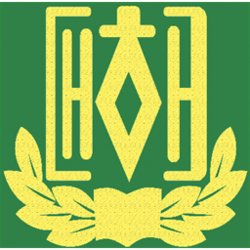Kim Il-sung University
(University) | |
|---|---|
 | |
| Formation | 1 October 1946 |
| Headquarters | North Korea |
| The first and most important university in North Korea | |
Kim Il-sung University, founded on 1 October 1946, is the first university built in North Korea. It is located on a 15-hectare (37-acre) campus in Pyongyang, the nation's capital. Along with the main academic buildings, the campus contains 10 separate offices, 50 laboratories, libraries, museums, a printing press, an R&D centre, dormitories and a hospital.[1] There is a sizeable computer lab, but it has only limited internet access.[2] The university is named in honour of Kim Il-sung, the founder and first supreme leader of North Korea.
Kim Il-sung University has around 16,000 enrolled students, and provides courses in the fields of social sciences, law, arts and sciences.[3] In the spring of 2017, Kim Il-sung University set up specialist Japanese language and literature courses.[4] Courses in both the department of social sciences and the department of natural sciences take five years to complete.
History
On 25 May 1946 the Preparatory Committee was composed by the founding universities. In July 1946, the interim People's Committee of North Korea decided to establish a University (ordinance No. 40). Kim Il-sung proclaimed on 1 October 1946 the founding.
In 1948, four university faculties (Faculty of Engineering, Transportation Engineering, Faculty of Agriculture, Faculty of Medicine) were separated from Kim Il-sung University, to form the origin of Pyongyang University of Technology (currently Kim Chaek University of Technology), Sariwon Agricultural University and Pyongyang University School of Medicine.
During the Korean War, the university was located at Baeksong-ri under Mount Jamo in Suncheon-gun, which was far from the centre of the city. By late 1955, the reconstruction of the main building on the Pyongyang campus was in progress and soon the university moved back to the centre of Pyongyang.
After the war, Kim Il-Sung University became known as a hotbed of intellectual dissent. Academics supported more intellectual freedoms than Kim loyalists, and disadvantageous factions within the Workers' Party of Korea were over-represented in university staff. Following the uprisings in 1956 in Hungary and Poland, North Korean exchange students were quickly repatriated from the affected countries. The students started asking "improper" questions on campus, causing alarm. After that, up to one hundred students and several prominent staff members were purged. The purging of the university gave further impetus to purges against functionalists all over the country.
By the end of 1970s more than 50,000 students graduated annually from the university. In addition, the university was an important asset of for the Korean People's Army to train its personnel. Since the 1970s, English courses have been taught at the university.
Until 2004, Pak Kwan-o, an authority on nuclear physics and current Chairman of the People's Committee of Pyongyang (de facto Mayor), had been serving as the president for 17 years. Since 2009, its president was Song Ja-reeb. The current president since 2014 is Thae Hyong-chol.[5]
According to Korean Central Television, North Korean students can take classes at and download lectures from Kim Il-sung University via the Mirae public WiFi network, beginning in 2018.[6]
Notable alumni
Template:Incomplete alumni list
- An Kyong-ho, Chief Director of the Committee for the Peaceful Reunification of the Fatherland
- Kim Jong-il, former leader of North Korea, attended 1960–1964
- Kim Jong-un, Supreme Leader of North Korea since December 2011, said to have attended 2002–2007.
- Kim Pyong-il, half-brother of Kim Jong-il and ambassador to Czech Republic
- Kim Yo-jong, sister of Kim Jong-un, said to have studied Computer Technology alongside Japanese abductee Megumi Yokota's daughter, Kim Eun-gyon.[7]
- Kyong Won-ha, nuclear scientist
- Andrei Lankov, Kookmin University professor and former Australian National University lecturer, attended as an exchange student in 1985
- Rüdiger Frank Professor for East Asian Economy and Society, attended as an exchange student in 1991/1992
- Paek Nam-sun, former Minister of Foreign Affairs
- Sin Son-ho, previous Permanent Representative of North Korea to the United Nations
- Zhang Dejiang, former Chairman of the Standing Committee of the National People's Congress and former member of Politburo Standing Committee of the Communist Party of China.
- Ri Sol-ju, first lady of North Korea and wife of North Korean leader Kim Jong-un.
- Thae Jong-su, North Korean politician[8]
An Alumnus on Wikispooks
| Person | Born | Nationality |
|---|---|---|
| Kim Jong-un | 8 January 1982 | North Korea |
References
- ↑ http://terms.naver.com/entry.nhn?docId=553237
- ↑ https://www.bbc.com/news/world-asia-36199683
- ↑ https://www.youngpioneertours.com/kim-il-sung-university/
- ↑ https://www.japantimes.co.jp/news/2019/12/09/national/prestigious-pyongyang-university-teaching-specialist-japanese-language-literature-courses/#.XqEZn5MzbBI
- ↑ http://www.naenara.com.kp/en/order/pytimes/?page=Politics&no=17881
- ↑ https://archive.today/20181114162817/https://www.nknews.org/2018/11/smartphone-capable-wifi-on-show-at-pyongyang-it-exhibition-state-tv-reveals/
- ↑ http://koreajoongangdaily.joins.com/news/article/article.aspx?aid=2986592
- ↑ http://www.nkleadershipwatch.org/leadership-biographies/thae-jong-su/

